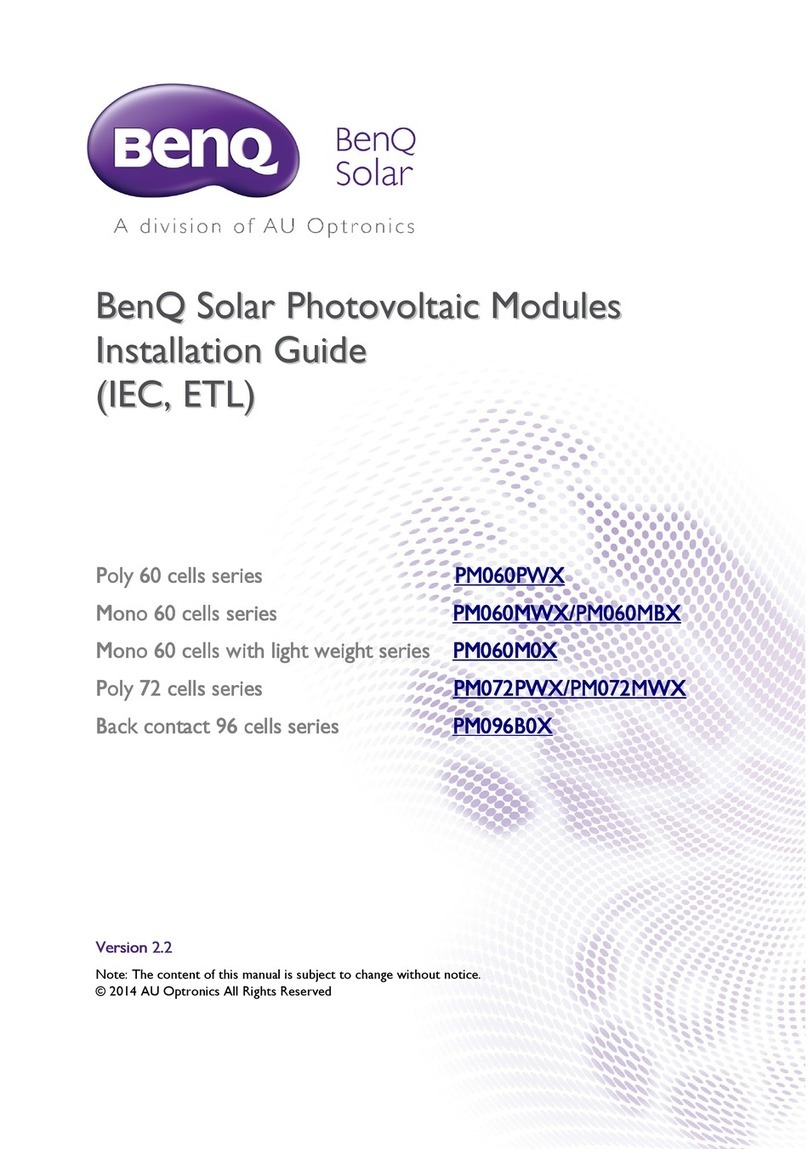
Last revised: May 7, 20 3
.4 General Safety Reminders
IMPORTANT
IMPORTANTIMPORTANT
IMPORTANT
THIS PRODUCT IS DESI
THIS PRODUCT IS DESITHIS PRODUCT IS DESI
THIS PRODUCT IS DESIGNED FOR INSTALLATIO
GNED FOR INSTALLATIOGNED FOR INSTALLATIO
GNED FOR INSTALLATION
N N
N BY QUALIFIED PERSONN
BY QUALIFIED PERSONNBY QUALIFIED PERSONN
BY QUALIFIED PERSONNEL
ELEL
EL ONLY
ONLY ONLY
ONLY.
..
.
ALL HANDLING AND INS
ALL HANDLING AND INSALL HANDLING AND INS
ALL HANDLING AND INSTALLATIONS MUST BE P
TALLATIONS MUST BE PTALLATIONS MUST BE P
TALLATIONS MUST BE PERFORMED IN COMPLIAN
ERFORMED IN COMPLIANERFORMED IN COMPLIAN
ERFORMED IN COMPLIANCE WITH
CE WITH CE WITH
CE WITH
ALL APPLICABLE CODES
ALL APPLICABLE CODESALL APPLICABLE CODES
ALL APPLICABLE CODES,
,,
, RULES AND REGULATIO
RULES AND REGULATIO RULES AND REGULATIO
RULES AND REGULATIONS.
NS.NS.
NS.
In addition to the applicable rules and regulations, please follow all guidelines for safe handling
and/or installation of BenQ Solar modules. In addition to the guidelines below, always
observe industry best practices when handling and/or installing any BenQ Solar module.
.5 Guidelines for Handling and Installation
LIFTING AND HANDLING
LIFTING AND HANDLINGLIFTING AND HANDLING
LIFTING AND HANDLING
Do not lift the module or carry module by junction box or PV cables.
Do not drill holes in the frame.
Avoid scratching the frame. Scratches to the frame will compromise protective coating
and can result in corrosion or weakened structure.
Do not scratch or damage the module backsheet. Scratches to the backsheet could
affect module performance.
Do not stand on, drop, scratch or allow objects to hit modules (especially module glass).
Do not install or handle the modules when wet or during periods of high wind.
Do not install the modules where there may be flammable gases or vapors, since sparks
may be produced.
Save these instructions for future reference.
ELECTRICAL HANDLING
ELECTRICAL HANDLINGELECTRICAL HANDLING
ELECTRICAL HANDLING AND INSTALLATION
AND INSTALLATION AND INSTALLATION
AND INSTALLATION
Mo
MoMo
Modules interconnect
dules interconnectdules interconnect
dules interconnect points
points points
points
conduct
conductconduct
conduct direct current (DC) and are sources of voltage
direct current (DC) and are sources of voltage direct current (DC) and are sources of voltage
direct current (DC) and are sources of voltage
when the module is under load and when it is exposed to light.
when the module is under load and when it is exposed to light. when the module is under load and when it is exposed to light.
when the module is under load and when it is exposed to light.
Direct current can arc across gaps and may cause injury or death if improper connection
Direct current can arc across gaps and may cause injury or death if improper connection Direct current can arc across gaps and may cause injury or death if improper connection
Direct current can arc across gaps and may cause injury or death if improper connection
or disconnection is
or disconnection isor disconnection is
or disconnection is made, or if contact is made with module leads that are frayed or
made, or if contact is made with module leads that are frayed or made, or if contact is made with module leads that are frayed or
made, or if contact is made with module leads that are frayed or
torn.
torn.torn.
torn.
































